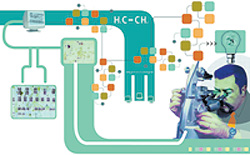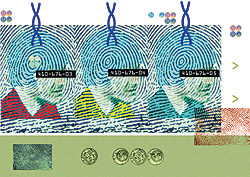
Patients suffering from cancer have been given new hope through the successful development and application of a new treatment.High intensity focusing ultra-sound (HIFU), has been developed by Chongqing Medical Science University through 11 years of research.It has been used to treat hundreds of patients from across Chongqing Municipality.
Li Kaiyi, 65, who received HIFU treatment in March 1998 for an egg-sized tumour in her left breast, have looked fine today."I couldn't raise my left arm before the HIFU operation but now I can move it freely," said Li.
"The operation wasn't painful. Moreover, I could do housework the next day after the operation," she recalled.
HIFU can remove tumours without leaving scars and producing side-effects. It can also minimize the possibility of tumours growing, according to the university's professor Wang Zhibiao.
This medical case is simply an example of how does China's technological progress contribute to economic sectors and social development.
Efforts have paid off since the central government began to implement the strategy of "revitalizing the nation through science and education" in 1995, and began to invest heavily in technological development since then.
China has achieved remarkable progress in seeking new technological discoveries, which have been important to the national economy over the past few years.
Technological progress has been beneficial in the agriculture, industry, energy, transport, natural resources exploration and utilization, environmental protection, health, medical care and disasters prevention and mitigation sectors.

AGRICULTURE
Chinese farmers can now raise their productivity thanks to advanced information technology.
Computer-based information technology has helped increase agricultural production in the city of Beijing, and Jilin, Anhui and Yunnan provinces,swheresinformation technology has been piloted.
As early as in 1992, the Ministry of Science and Technology began to organize scientists to develop agricultural specialists' systems. The systems cover databases ranging from State agricultural policies, regional regulations and market demand information, to advanced technology for crop growing, forestry, animal husbandry and aquatic products.
The system was massively experimented in the above four areas in 1998, aiming towards allowing farmers to learn advanced technologies for growing major crops: rice, wheat, maize, cotton and soybean. To date, grain outputs in the four areas have increased by a large margin.
In Beijing alone, the system has been tried on 266,000 hectares of arable lands, producing an additional 107 million kilograms of grains, according to statistics from the Beijing Science and Technology Committee.Information technology is significant as China's agricultural production is shifting from the previous labour-intensive mode to the modern technology-driven one.
Some developed countries, such as Japan and the United States, had popularized information technologysintosagricultural production earlier than China, according to Gao Wen, a specialist engaging in the development of the systems.
The agricultural specialists' systems can disseminate various farming skills to farmers with different educational backgrounds, said Gao.

For example, through computer pictures, Chinese characters and phonetic system, farmers can easily learn which areas are in need of grains, or when and how much fertilizer the crops need, said Gao.
The Ministry of Science and Technology said this system will be further expanded in other farming regions in the next few years.
Starting 1995, the ministries of agriculture and science and technology began a project of planting crops of high-yield rice, wheat, maize, cotton and soybean in Hunan, Henan, Jilin and Heilongjiang provinces and in the Xinjiang Uygur Autonomous Region.
The move was aimed at helping increase agricultural output in the above areas, which together form part of China's large grain and cotton producing region, so as to mobilize other farming regions to further raise productivity.
The project has been carried out on 290 million mu (more than 19 million hectares) spreading throughout the five regions. Latest statistics indicate that this high-yield crops project has increased production of grain by a total of 21.9 billion kilograms and cotton by 28.4 million dan (roughly 1.4 billion kilograms).
The high-yield project started as a response to situation that arose in the early 1990s in which grain production was falling while demand for grain was increasing.
In 1994, China's grain output fell by 11 billion kilograms, while grain consumption increased by 13 billion kilograms.
In 1995, the ministries decided to take measures to stop the grain crisis before it started.
"Chinese scientists have made many technological breakthroughs for raising rice, wheat, maize, soybean and cotton production over the recent few years, and consequently, the country's grain output has been increased by a large margin," said Lu Liangshu, a researcher with the Chinese Academy of Agricultural Science.
Lu also said, however, that more should be done to improve the quality of grain because the quantity of grain in China is now sufficient, and farmers can currently afford to concentrate on increasing the protein content of both rice and maize.
POVERTY RELIEF
Advanced technology has also played a significant role in easing poverty in rural areas over the past few years.
The Ministry of Science and Technology, the Chinese Academy of Sciences and the Chinese Association for Science and Technology jointly launched poverty-relief projects in 1986, in the Dabie Mountain area in Anhui and Hubei provinces, the Jinggang Mountain area in Jiangxi Province, the north Shaanxi Province, the Loess Plateau, the Guangxi Zhuang
Autonomous Region and the Luliang Mountains area in Shanxi Province. These areas are baffled with adverse eco-system and backward economic and technological conditions.
The three departments' efforts have paid off over the past 15 years.
In the north of Shaanxi Province, and the Dabie Mountain areas, for example, the number of people suffering from poverty has been reduced to 500,000 from the 9.4 million of 1986.
A total of 290,000 scientists and technicians have been sent to poor areas over the past 15 years. They have introduced 9,400 kinds of applied technologies to thousands of farmers, relevant statistics show.
Each farmer has learnt two advanced agricultural techniques and increased his income. In the Luliang Mountain area, for example, farmers' incomes have been increased to an average of 1,367 yuan (US) from the previous 318 yuan (US) per year.
INDUSTRY
Technological progress has provided powerful support for industrial development over the past few years.
A new oil extraction technology has enabled the Daqing Oilfield in Northeast China's Heilongjiang Province and the Shengli Oilfield in eastern Shandong Province to raise oil production threefold, last year's statistics indicated.
Starting June 1999, the government set aside a special fund of 1 billion yuan (US million) to back the technological innovations of small and medium firms for the next few years.
In 1999, the first year when the special fund wentsintosoperation, an investment of 816 million yuan (US million) was disbursed among 1,089 high-tech firms.
The 1,089 firms have produced an additional 32.9 billion yuan (US.96 billion) of industrial output. They have also helped create more than 140,000 new jobs.
These firms are involved in information technology, biology, new materials, natural resources and environment, and optics, machinery and electronic integration, according to the Administrative Centre of Innovation Funds for Technological Small and Medium Firms.
This special fund will continue to support technology-intensive firms in the future, sources from the Ministry of Finance said.
The country has also made a great progress in developing information technology, biological engineering and other high-tech industries.

The country has set up 53 State-level high-tech zones since the central government began to highly support the development of high-tech industries in the early 1990s.
A total of 23,000 technological firms have sprung up in the 53 zones, with 2.8 million employees involving in jobs.
Last year, the volumes of industrial output of these firms hit 1,000 billion yuan (US billion), rising 25.9 per cent than 2000.
Last year, global high-tech industries registered a sluggish development. But China remained an increasing export of computer, communications and other high-tech products.
The country's export volume of high-tech products hit US.4 billion last year, up 24 per cent over 2000, according to statistics from the
Ministry of Science and Technology.
High-tech products now account for more than 15 per cent of the country's foreign trade volumes. The ratio is expected to rise to over 20 per cent in 2005 and more than 30 per cent by 2010, sources from the ministry said.
Background
Scientific and educational sectors had been dumped to the bottom of social ladders in China during the ``cultural revolution'' period (1966-76).
In 1978 when the country was geared to the track of reform and opening-up policies, the central government held a national conference of science and technology.
China's late paramount leader Deng Xiaoping gave his remarks that "science and technology are prime productive forces" at the conference, thus an atmosphere of respecting knowledge and talents was gradually created.
The conference, regarded by Chinese scientists as "renaissance of science", greatly stimulated the enthusiasm of scientific circles. Since then, a series of policies, regulations and plans for scientific development were implemented to push China's science and technology progress.
In 1982, the National Key Technologies Research and Development Programme was kicked off to upgrade old industrial and agricultural sectors with the latest techniques.
The programme had greatly benefited agricultural and industrial development over the past two decades.During the Ninth Five-Year Plan (1996-2000) period, for example, the popularization of high-yield crop seeds and other new technology had helped swell the country's harvest of grain by 150 million kilograms.
In 1986, the Ministry of Science and Technology initiated the Spark Programme to boost rural economy through advanced technology.
Over the past 15 years, the programme had been implemented in 85 per cent of counties throughout China, lifting economic growth in these areas to a new high. During the Ninth Five-Year Plan period alone, the programme helped these counties gain a total profit of 281 billion yuan (US billion).
In the 1980s, some developed countries began to initiate technology innovation to reinforce their national defence, economy and other sectors. In 1985, for example, the high-tech ``Eureka Programme'' was kicked off in the Europe.
In March 1986, China started the ``863 Programme'' to strengthen its comprehensive competitiveness, especially economic and national defence sectors, through high technology.
Under the programme's guidance, the country has fostered such high-tech industries as information technology, biology, new materials, manufacturing and automation technologies, energy and environment.
In 1988, China launched the Torch Programme -- a plan for the development and commercialization of high-tech industries. It was designed to brave the challenge of the worldwide new technology wave, to upgrade traditional industries as well as to nurture domestic high-tech sectors.
Asgroupsof new industries covering such fields as new materials, bio-engineering, electronics, information technology, energy-saving and environmental protection, have sprung up across the country under the Torch Programme's policy umbrella.
In 1995, the central government put forward the strategy of "revitalizing the nation through science and education", to further provide policy support for the country's scientific development.

In 1998, Premier Zhu Rongji highlighted this strategy in his governmental working report. And the central governmental set up a National
Leadingsgroupsfor Science and Education to help stipulate significant national scientific projects and policies.
Governmental funding for scientific development had increased drastically over the past few years.
In 2000, for example, the Chinese Government invested more than 57.6 billion yuan (US.9 billion) in science and technology, an increase of 4.8 per cent over the previous year, according to the latest statistics from the Ministry of Science and Technology.
The statistics also show that regional governments' science funding in 2000 grew by an average of 20 per cent over 1999.
| ![]() 本网站由北京信息港提供网络支持
本网站由北京信息港提供网络支持




